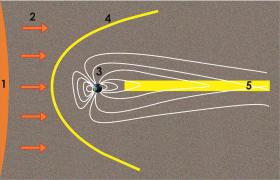
1 – Sun; 2 - Flow of plasma particles outgoing from the Sun; 3 – Magnetosphere; 4 – Magnetopause; 5 - Magnetotail current sheet. The regions of possible localizations of thin current sheets are marked by yellow color. Image: Helmi Malova
Series of models that adequately describe both real processes in thin current sheets in the Earth’s magnetosphere and their properties is proposed. The obtained modelling results are not only confirmed by satellite observations, but can also predict them. Corresponding reports will be done on 40-th Scientific Assembly of the International Committee for space research (COSPAR) by Helmi Malova, doctor of physical and mathematical sciences, senior research scientist of the Scobeltsyn Institute of Nuclear physics of Lomonosov Moscow State University (NPI MSU) and leading research scientist of Space Research Institute of the Russian Academy of Sciences (IKI RAS).
Plasma particles outgoing from the Sun, i.e. protons and electrons, flow around the Earth’s magnetosphere, resulting in the formation of relatively thin current sheet named magnetopause, which separates the magnetosphere from the incoming flow. Plasma particles can also penetrate the magnetosphere, leading to a formation of the current sheet in its elongated part named magnetotail. Its thickness depends on the conditions of solar plasma - magnetosphere interaction. During magnetic perturbations, i.e. substorms, the magnetotail current sheet may be thinned from the thickness of tens of thousands of kilometers to several hundred kilometers, and then to be destroyed in its near-Earth region. The destruction of thin current sheet can also take place when excessively large number of trapped particles is accumulated within it. After current sheet destruction accelerated particle flows are directed, on the one hand, to the Earth’s polar regions, resulting in polar auroras. On the other hand, the current sheet disruption leads to the formation of giant plasma bubbles, named plasmoids that walk away from the planet and, finally, leave the magnetosphere.
The main feature of the proposed series of models is the taking into account the structure and evolution dynamics of thin current sheets in the Earth’s magnetosphere. “Current sheets can be bifurcated, deformed; they can oscillate and be destructed. They are similar to "living organisms” that incessantly change, evolve, and complicated processes take place in them", - explained Helmi Malova.
These models are developed within the framework of the scientific cooperation between the scientists of Moscow State University and the Russian Academy of Sciences (scientific leader of the research group is the academician Lev Zelenyi, director of IKI RAS).
The scientists of Skobeltsyn Institute of Nuclear Physics, Physical Faculty of Moscow University, and Institute of Applied Geophysics of Kola Research Center of RAS investigate the properties of thin current sheets with help of developed models. The researches of particle dynamics in thin current sheets were done in cooperation with Dominique Delcourt, the world famous scientist from Ecole Polytechnique in Paris, and Surja Sharma, scientist from Maryland University in College Park USA, high-level specialist in dynamical chaos in complex systems. Some satellite observations in space made by a group of Professor Wolfgang Baumjohann from the Austrian Academy of Sciences were compared with model results, and a good agreement between them was demonstrated.
Investigations of thin current sheets in the magnetosphere are required for the understanding of fundamental basis of interaction of space plasma and electromagnetic fields in the interplanetary and cosmic space that are necessary for space weather monitoring and prediction. "One should predict space weather not only to warn the threat to satellites and astronauts. Intensive streams of charged particles in the ionosphere induce strong electrical currents on the Earth's surface, which may damage the gas pipelines, navigation systems and communications, transformer substations, leaving the whole cities without electricity", - said Victor Popov, doctor of physical-mathematical Sciences, Professor of Moscow State University, the IKI RAS and Financial University.
The results of this study are presented at the COSPAR Assembly by two reports: "Quasi-adiabatic current sheet with magnetic shear: the structure and evolution" and "Magnetotail current sheet in the regime of chaotic dynamics of plasma particles", that are scheduled for August 5 at 9 hours 30 minutes (D3.1-0028-14) and August 6 at 15 hours 30 minutes (D3.2-0012-14) at: Lomonosovsky Prospekt, 27/1 (Lomonovsky Building), room L1-05, 2nd floor.
